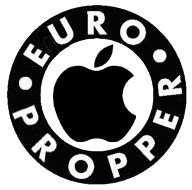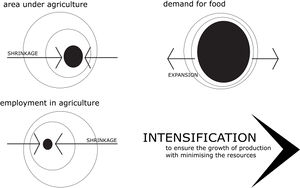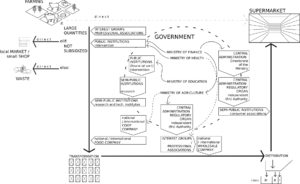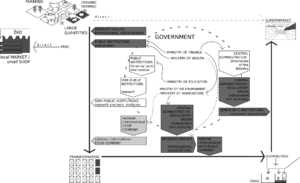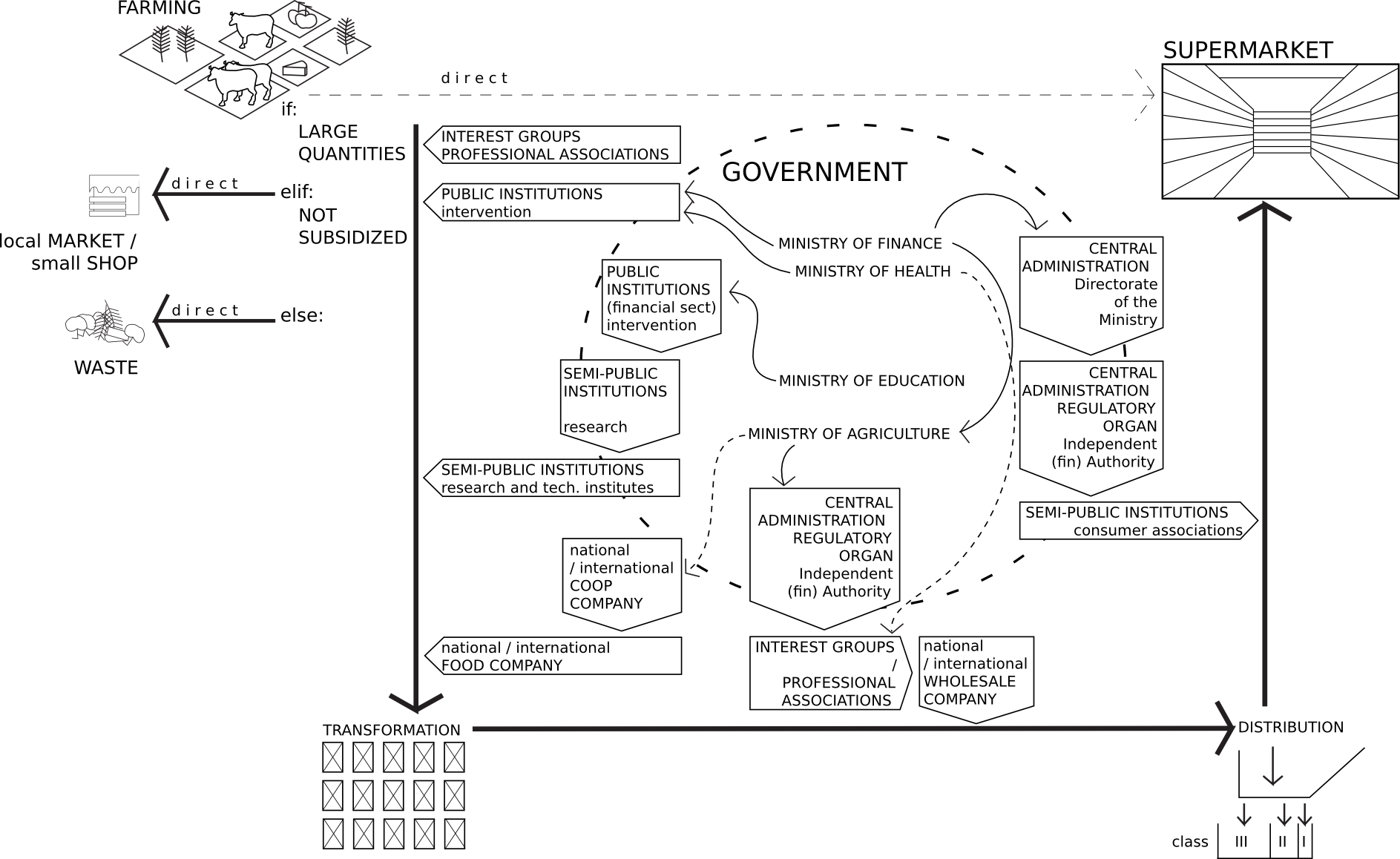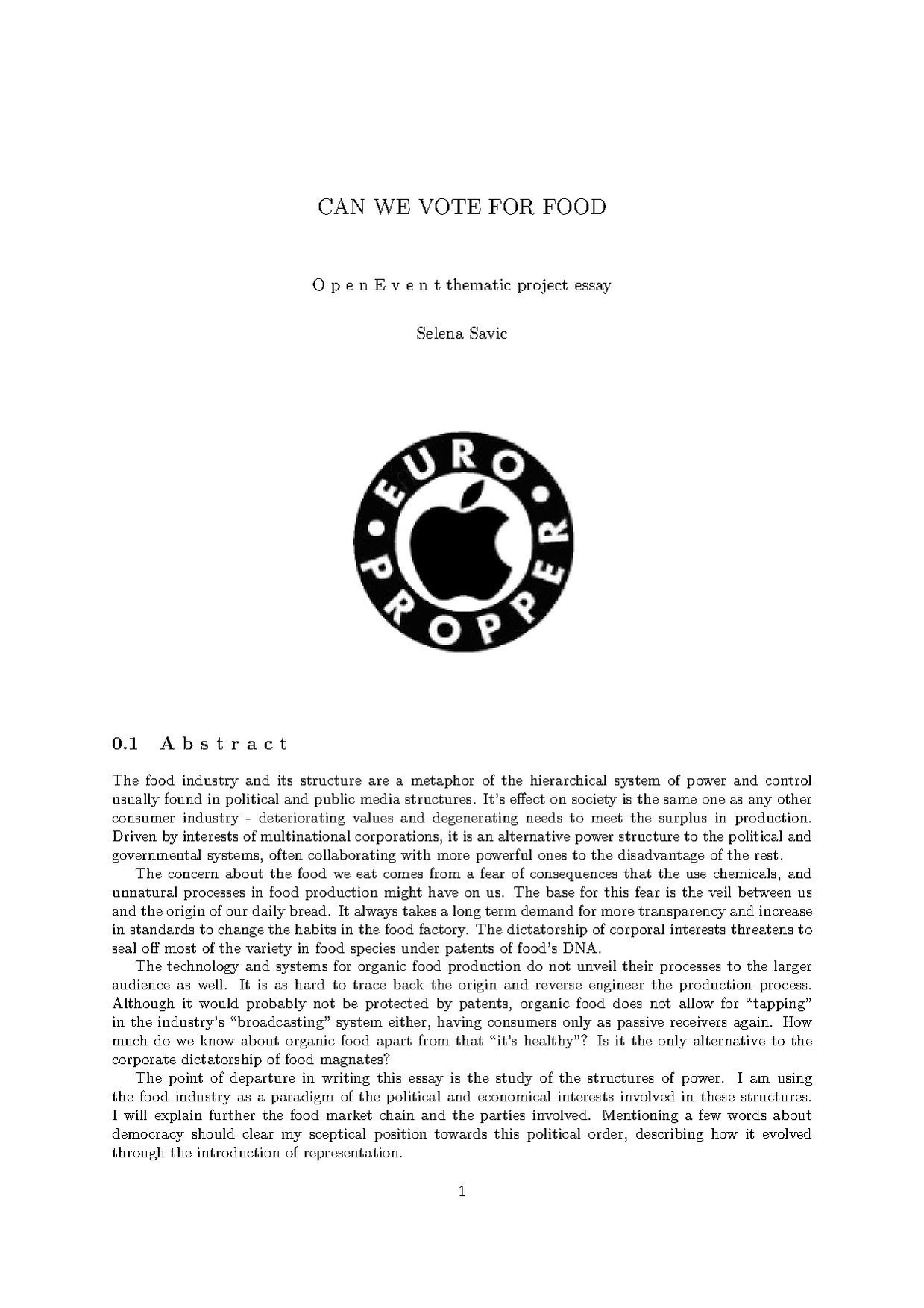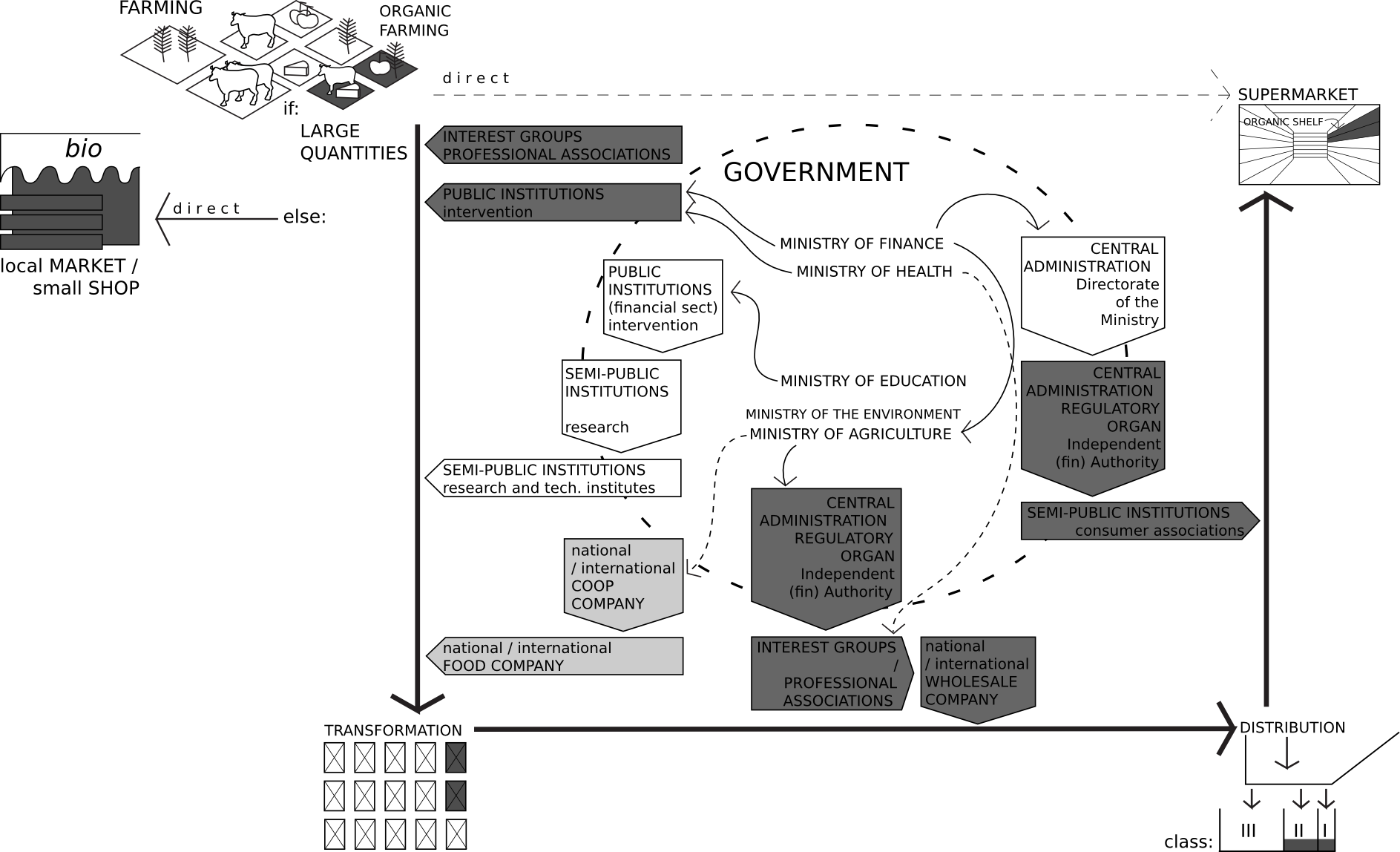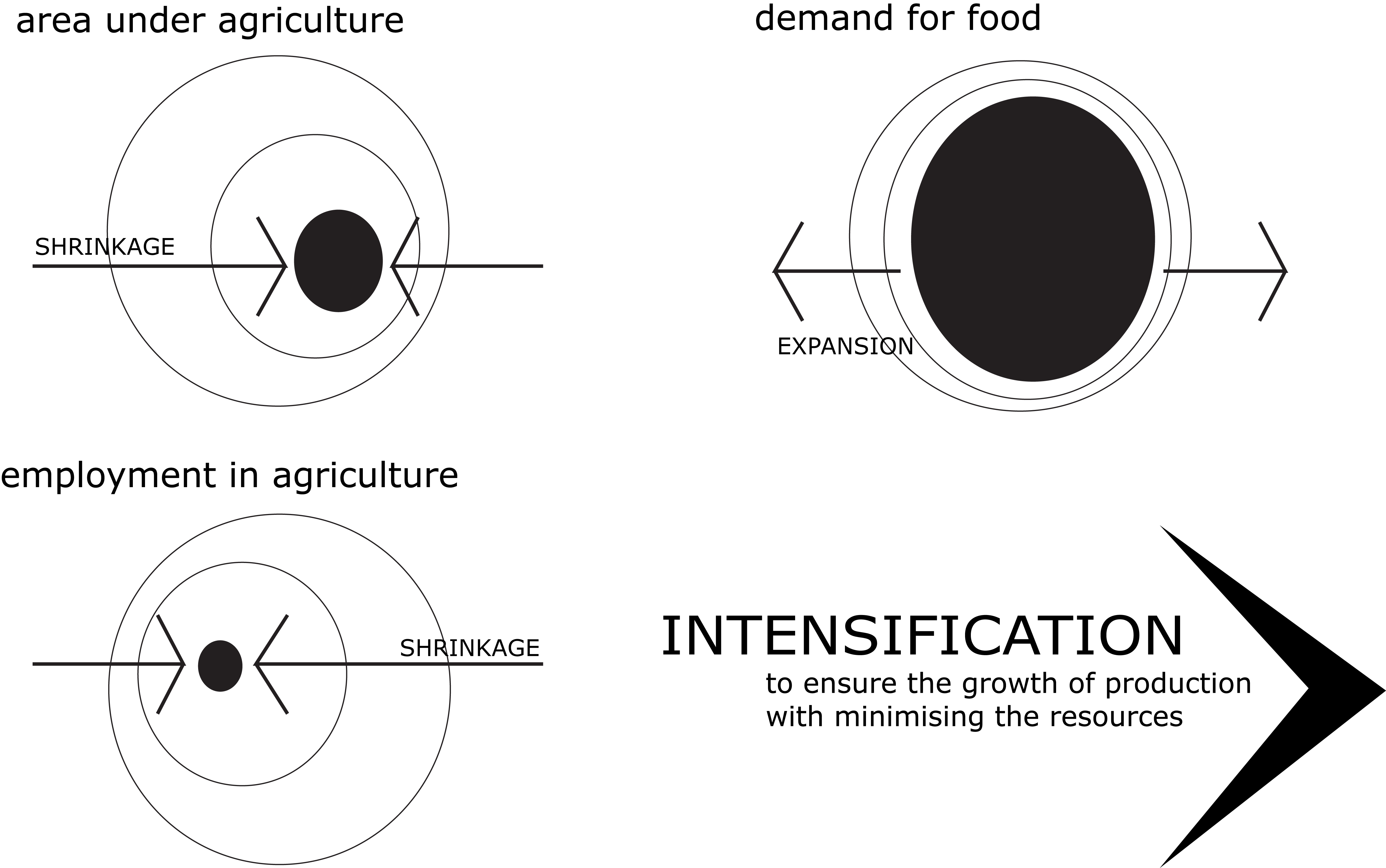User:Selena Savic/VoteForFood
CAN WE VOTE FOR FOOD
A b s t r a c t
The food industry and its structure are a metaphor of the hierarchical system of power and control usually found in political and public media structures. It's effect on society is the same one as any other consumer industry - deteriorating values and degenerating needs to meet the surplus in production. Driven by interests of multinational corporations, it is an alternative power structure to the political and governmental systems, often collaborating with more powerful ones to the disadvantage of the rest.
The concern about the food we eat comes from a fear of consequences that the use chemicals, and unnatural processes in food production might have on us. The base for this fear is the veil between us and the origin of our daily bread. It always takes a long term demand for more transparency and increase in standards to change the habits in the food factory. The dictatorship of corporal interests threatens to seal off most of the variety in food species under patents of food's DNA.
The technology and systems for organic food production do not unveil their processes to the larger audience as well. It is as hard to trace back the origin and reverse engineer the production process. Although it would probably not be protected by patents, organic food does not allow for "tapping" in the industry's "broadcasting" system either, having consumers only as passive receivers again. How much do we know about organic food apart from that "it's healthy"? Is it the only alternative to the corporate dictatorship of food magnates?
The point of departure in writing this essay is the study of the structures of power. I am using the food industry as a paradigm of the political and economical interests involved in these structures. I will explain further the food market chain and the parties involved. Mentioning a few words about democracy should clear my sceptical position towards this political order, describing how it evolved through the introduction of representation.
I n t r o d u c t i o n
Supermarkets are today the main source of groceries for the average consumer in developed countries. Packed with varieties of the same type of product, they tend to offer everything from food to household stuffs under one large roof. Some have an organic chain of products next to several non-organic brands, to satisfy more careful shoppers. What is "the way of the food" we eat today, how can it reach the buyer and for what price?
"The way we eat has changed more in the last 50 years than in the
previous 10,000, but the image that is used to sell the food are the
picket fence, the silo, the 1930s farmhouse and green grass...The
reality is – it’s not a farm, it’s a factory."
Food Inc. 2008 *2
The makers of the movie "Food Inc." presented the idea of food consumption as a voting poll. The fact is that both the food and the marketing industry have convinced consumers to feel only as recipients of whatever they have put out for them to consume. In order to claim back the power (and responsibility) of the people (consumers) changes on both sides need to happen. But we cannot fully control our nutrition. We cannot participate further than choosing for what is already offered.
The Order of Democracy
From equality among people or a qualified group of people (freemen, property owners, the wise....) through different interpretations of "democratic" and "ruling" (people rule over people, people choose who rules, rulers choose people....) Raymond Williams presents a development of the notion of the word "democracy" in his book Keywords.
In relation to public space seen as the public domain, or public sphere, Parkinson introduces three types of democracy, referring to Goodin’s definition by which "Democracy boils down to making social outcomes systematically responsive to the settled preferences of all affected parties... Whether public space matters to democracy depends on what kind of democrat we are talking about" *3 Parkinson distinguishes:
- participatory model (face to face; takes place at an agora)
- representative (one to many; requires enclosed assemblies, takes place in a parliament)
- pluralist (many to many more; requires more open access by citizens to their representatives, takes place in a physical space where citizens can express their symbolic dominance) *4
Raymond Williams later quotes Bentham who makes "general sense of democracy as rule by the majority of the people, and then distinguished between 'direct democracy' and 'representative democracy', recommending the latter because it provided continuity and could be extended to large societies." *5
Democracy was saved from its revolutionary connotation towards the end of the 19th century with the broader introduction of the representative model. The development of representative democracy in favour of the participatory or direct model helped in strengthening the hierarchical power relations, decentralizing the system on a larger scale but preserving the centralized model the building unit of society. "...Democracy is said to have been 'extended' stage by stage, where what is meant is clearly the right to vote for representatives rather than the old (and until the eC19 normal English) sense of popular power." *6 Wiliams concludes that it would be easier to stand for democracy if it stayed an unfavourable or factional term, rather then becoming a perspective that is to be found in nearly all political movements. This leads to innumerable distortions of the initial idea behind democracy, reducing the concepts of election, representation and mandate to formalities and the concept of popular power or government in the popular interest, to a slogan covering the rule of a bureaucracy or oligarchy.
The Bureaucratic System Behind the Centralized Food Industry
Who is the one today who can produce food? Who can afford to have their products distributed to the supermarkets?
In the process of deconstruction and demistification of the World's agricultural system, the artist collective Bureau d’Etudes drew a line from the Ford company’s business administration that was inspired by Prussian military organisation and that in return inspired the Ludendorff’s Economical Plan for the War (Kriegwirtschaftsplan) and Gosplan strategic plans in USSR, respectively; American administration was the first to, during the New Deal, apply Fordist planning on agriculture. This soon resulted in the country becoming the world’s main producer and exporter of wheat. Shortly after, the heavy surplus in wheat production was to be compensated by increasing the bread eating habits of foreign consumers. Finally in 1954, the surplus in production could be given out as food aid meant for fighting hunger in the world in the interest of the external politics of the United States. Similar things are happening today with soya and corn crops, especially with the use of corn syrup in the majority of the nutritional products in USA. *7
Intensification, as this shift in agricultural practice is known, is characterised by an increase in water abstraction, area under cultivation and use of heavy machinery; extended periods of cultivation and high inputs of man-made fertilisers and pesticides; and a reduction in the number of people employed. *1 The system of intensive production manages to produce a lot of food on a small amount of land at a very affordable price.
About 500 multinational corporations control the whole food industry;
they exercise power over hundreds of thousands of employees and
control the process from the seed to the supermarket. Centred around
maximising profit and minimising taxes, these companies are built on
hierarchies of power where economic interests are placed before social
and ecological necessity.
"McDonald's is the largest purchaser of ground beef in the USA and when they want their hamburgers to taste everywhere exactly the same, they change how ground beef is produced" *8
Unlike the third world and developing countries, a significant part of the budget of rich countries is intended each year to subsidize the production of certain foodstuffs. Initially established to help national economies overcome the Great Depression and post World War II food shortage, these subsidizing policies have significantly influenced the disbalance of production capacities and the profitability of food industries worldwide.
The government policy in the USA allows for production of corn bellow the costs of production. Farmers are payed to overproduce, driven by the large multinational interests. In Europe, the subsidized export of food contributes with ~2% to the gross domestic product but it makes agriculture, in return, unprofitable in developing countries, where the price of the locally produced food amounts to even three times more than the price of a European product.
"Even the conservative calculations of the World Bank assume that agricultural subsidies in the rich nations deprive farmers in poor countries of a market of at least 30 billion dollars. At the same time, the World Bank states that - as absurd as this sounds at first - if the subsidies were to be abolished this would benefit the agricultural sector to the tune of 250 billion dollars, albeit with a more just distribution: countries with low and medium incomes would profit the most at around 150 billion dollars." *9
On the other side, the food business in the rich countries is characterized by a growing scale of companies that control an increasing percentage of the food market. These companies keep farmers under control with loans and conditioning in investments. The farmers have in fact very little say in their own business and are like slaves to these companies. *21
The European Regulations
"Deciding how much money the EU will spend and how it will be spent is a democratic process." *13
Since the end of the Second World War, the development of agriculture in the EU has been driven by the pursuit of ever-higher levels of productivity and efficiency. The driving force behind this development has been the agricultural policies of the EU. The CAP (Common Agricultural Policy) was introduced in the early 1960s to provide financial support to farmers and the wider rural community. *1
The EU farm policy is a very complicated system, "a deep, broad forest for which there is no complete map" *10, as described once by the Commissioner Mariann Fischer Boel. The common agricultural policy (CAP) has undergone extensive reforms over the last two decades - most recently in 2003 when the EU abolished production-based farm aid. The new scheme still supports farmers incomes but allows them more freedom to grow what the market wants. Food production today accounts for around 55 billion Euros a year, or 40 percent of the EU’s budget. The EU farming sector employs 5 percent of the working population. *12
The EU food safety policy strategy legislates the safety of food and animal feed. It applies the same high standards across the EU. The Commission enforces EU feed and food law by checking its implementation into national laws of all EU countries, carrying out inspections in the EU and outside. *11
The most recent EU agricultural policies have lead to a shutting down of a large number of smaller farms and the transition of the whole food production to ever larger farms (coupled with the trend of outsourcing the production that isn't profitable under EU standards to other continents). On the other side lays the pressure coming from urban planning to turn all constructible ground into urban zones. Following this shift, the EU started subsidizing a small number of farms to maintain bio-organic growth, although to a far too small degree, according to the opinion of environmental and consumer protection organisations . *14
The Borders of Rules
The border of Europe does not encompass a fully independent ecosystem; the regulations for environmental protection apply only on the inside but are nevertheless affected by the "dirty" and unregulated technology from its surroundings.
The EU had in place a moratorium on the import of genetically modified seeds until 2004. Since then labeling of all foods containing GM constituents is compulsory. And since then genetic engineering has been increasingly infiltrating agriculture in new member and admission states, such as Bulgaria, Romania and Croatia. *15
When domestic production of feed stuffs is insufficient or unprofitable following such EU standards, it can easily be outsourced outside their borders, to its neighbouring countries or to other continents. Because of the lack of regulation on labeling secondary products produced from animals which have consumed GM feed stuff, this kind of food can then be imported and put on the market. Austria is one of the most resistant countries to the GM food rush. It has no GM food in the supermarket. This however does not count for secondary products. About 60% of the Austrian yearly import of soya is genetically modified. *23
Apart from the liberal standards for food growing in the third world countries, cheap labor is also a motivating factor for outsourcing production. Which stays profitable even after the transportation costs of lengthy trips the food has to make before it reaches its final destination. Even on a more local scale, a classic Viennese breakfast with all the ingredients sourced in Austria travels at least 5000km on the road. And this is why
"In 2002 transport stream analysis of the Austrian foodstuff value creation chain revealed that the road from field to table is becoming ever longer. In the last 30 years the transport output of the chain as a whole has risen by 125%." *16
"...wide-scale cultivation of genetically modified soya in countries such as Argentina is having huge negative impacts: use of crop sprays has risen drastically, forests are being felled and the nutritional situation of the inhabitants has by and large deteriorated dramatically." *17
GM Knows No Borders
Genetically modified plants are grown today on more than 60 million hectares worldwide, nearly 90% of the area being in North and South America, with 80% in the US, Argentina and Brazil. The United States alone plant over 50% of the world’s GM crops. At the same time, 3% or less of crop land in India and China is given to GM crops. The most grown GM plants today are soya (58%), maize (23%), cotton (12%) and rape (7%). *18
In 1996 the agricultural company Monsanto launched the pesticide called "Roundup". Next to the pesticide, they have patented the gene of the genetically engineered "Roundup Ready" soya bean that could resist the application of "Roundup". Then the prohibition against seed saving and re-planting was established in the USA. Monsanto now has 75 people employed solely to investigate and prosecute farmers for patent infringement.
Soon after the arrest of the Iraqi leader Saddam Hussein and the "friendly occupation" of the country by the US, a new legislation against seed saving was put in place, handing the seed market over to transnational corporations. The US has been imposing patents on life around the world through trade deals. In this case, a whole new chapter on Plant Variety Protection (PVP) has been inserted into Iraq's previous patent law. PVP is an intellectual property right (IPR) or a kind of patent for plant varieties which gives an exclusive monopoly right on planting material to a plant breeder who claims to have discovered or developed a new variety. *24
GM vs. Organic
Food production chain, from the seed to the supermarket: Mass produced food; The ones who can sell are the ones who produce LARGE QUANTITIES:
Food production chain, from the seed to the store: Organic farms; The ones who produce LARGE QUANTITIES sell to the supermarket; the bureaucratic apparatus behind is identical in most stages, to the previous one:
The majority of organic food available on the market is in fact
industrially produced. It uses less, or no artificial pesticides; it
produces an amount sustainable for the land, and it's production is
not driven by multinational corporations' interests. It is rather
driven by fashion, and sometimes owned by corporations.
The critics of organic food hype question it's production capacity for meeting the demand for food in the current population. *22
The development of the organic movement started off as a hippy trend, an opposition to the rational utilitarian mass produced food chains. Todays organic food is either a mass produced commodity for the middle classes in developed countries, or a rare and difficult to find line of products sold only in small local stores. The big break-through of organic foods into supermarkets was not only driven by the utopian ideals of environmentalists who saw it as a chance to offer their products to a greater audience, but also by the typical capitalist economy of diversity, who follows market trends to create a new, or niche market.
The graphical scheme is based on the diagram found in "La belle au bois dormant", published by Bureau d'Etudes in 2006, page 1, map titled "Gouvernement du systeme agroalimentaire"
Art is Like Act Like is Art
Shifting the context and with it, the function of an object or act is not any more simply a reference to Duchamp's pisoar. When artists take up illegal actions or create documents that carry some more general objective information than an artwork usually does, it negates it's potential use, transfering them in the field of artistic practice.
In 1999, British artist Heath Bunting developed the Superweed Kit 1.0 "to threaten the governments with the same tools they are usually threatening us". This is withal the general attitude explained under the CTA:
The Cultural Terrorist Agency (CTA) is a funding agency committed to supporting contestation of property and representation. CTA turns it's enemies best weapon, that being investment, back onto itself.
We provide tactical finance support for combatant individuals and groups from our central fund, made up of combined multiple pledges.
This highly mobile central fund can be deployed immediately to areas of conflict with capitalist fundamentalists. *25
SuperWeed Kit 1.0 was a low-tech DIY kit designed to seed a genetically mutant SuperWeed which would be resistant to corporate monoculture practices, such as "Roundup Ready" crops.
The artist based his intervention on the premiss that the mutated weeds would occur anyway as a part of the process of adaptive evolution of organisms exposed to new conditions. Trying to play one step ahead of the corporate business, he uses the exact same strategy biotech company like Monsanto applies to nature.
"By releasing SuperWeed 1.0 into the environment long before biotech companies have a suitable fix, you will contribute to large losses in their profitability, thus causing them to reassess their future strategies and investments." *26
Several years later, Kayle Brandon and Heath Bunting, acting as the DUO Collective, published their maps of food available for free in a British city. They have conducted a detailed survey of edible plants that live within the public realms of Bristol. They investigated potential planting sites, with the aim to increase the life spectrum of the city. *27
This project resembles the practices of other artists, working on the border of utilitarianism and activism, to reconstruct the link between the immediate surrounding and our basic needs. Encouraging people to map and use edible, naturally occuring foodstuffs is part of a larger and spontaneously emerging network of initiatives. The idea of tapping into public space and making individual use of it has been around since the globalization movement that made it cheaper to eat food that has been grown 1000s of kilometers away from where we stand.
Guerilla gardening restores the practice of food growing in urban areas that has been promoted by governments in big American cities after World War II. Making use of all available land to grow food is not only beneficial for land management but also reestablishes the immediate connection between us and the food we eat, as we can see where the food is coming from. *28
In the Fallen Fruit manifesto, we read:
"A specter is haunting our cities: barren landscapes with foliage and flowers, but nothing to eat. Fruit can grow almost anywhere, and can be harvested by everyone. Our cities are planted with frivolous and ugly landscaping, sad shrubs and neglected trees, whereas they should burst with ripe produce. Great sums of money are spent on young trees, water and maintenance. While these trees are beautiful, they could be healthy, fruitful and beautiful." *29
Picking up food that is already there refers to the old gleaners tradition of collecting the leftover crops from farmers' fields after they have been commercially harvested. In todays setup, we are talking about supermarkets where food is thrown away after the expiry date or an arbitrary date after which it cannot be sold anymore. Fallen fruit and similar initiatives question the hidden capitalist habit to think of throwing away as an act of novelty, proving that we have more than enough. In fact, this throw away society is the perfect environment for capitalizing on overconsumption. Throwing away with dignity.
These described practices do not call for a big fix, but force us to rethink and reconsider our habits. One solution for it all is too aggressive. And voting may be too passive.
- 1 Agriculture in the EU, B. Halahan, April 2009, http://www.wwf.org.uk/filelibrary/pdf/ag_in_the_eu.pdf
- 2 Food Inc., a movie by Robert Kenner, 2006.
- 3 Robert Goodin, Liberalism and the Best-Judge Principle
- 4 John Parkinson, "Democracy, Architecture and Public Space", University of York, posted in January 2006, http://www.claimingpublicspace.net/modules.php?name=News&le=article&sid=77
- 5 Raymond Williams, Keywords, Fontana Communications Series, London, Collins, 1976. p. 95
- 6 ibid, p. 96
- 7 Bureau d’etudes, La belle au bois dormant, final edition, 2006, p. 4, "L’agriculture conquise"
- 8 Food Inc., a film by Robert Kenner, USA, 2006.
- 9 We Feed The World, a film by Erwin Wagenhofe, Austria, 2005. http://we-feed-the-world.at/en/facts4.htm
- 21 Food Inc.
- 10 http://ec.europa.eu/news/agriculture/090318_1_en.htm
- 11 http://europa.eu/pol/food/index_en.htm
- 12 http://ec.europa.eu/news/agriculture/081119_1_en.htm
- 13 http://europa.eu/pol/financ/index_en.htm
- 14 We Feed The World, a film by Erwin Wagenhofe, Austria, 2005. http://we-feed-the-world.at/en/facts3.htm
- 15 We Feed The World, a film by Erwin Wagenhofe, Austria, 2005. http://we-feed-the-world.at/en/facts.htm
- 23 same source
- 16 We Feed The World, a film by Erwin Wagenhofe, Austria, 2005. http://we-feed-the-world.at/en/facts5.htm
- 17 We Feed The World, a film by Erwin Wagenhofe, Austria, 2005. http://we-feed-the-world.at/en/facts.htm
- 18 http://www.foeeurope.org/GMOs/Index.htm
- 22 http://www.cosmosmagazine.com/node/15
- 24 http://www.grain.org/articles/?id=6
- 25 http://www.irational.org/cta/
- 26 http://www.irational.org/cgi-bin/language/language.pl?url=http://www.irational.org/cta/superweed/kit.html&language=english
- 27 http://duo.irational.org/food_for_free/
- 28 http://www.guerrillagardening.org/
- 29 http://fallenfruit.org/

